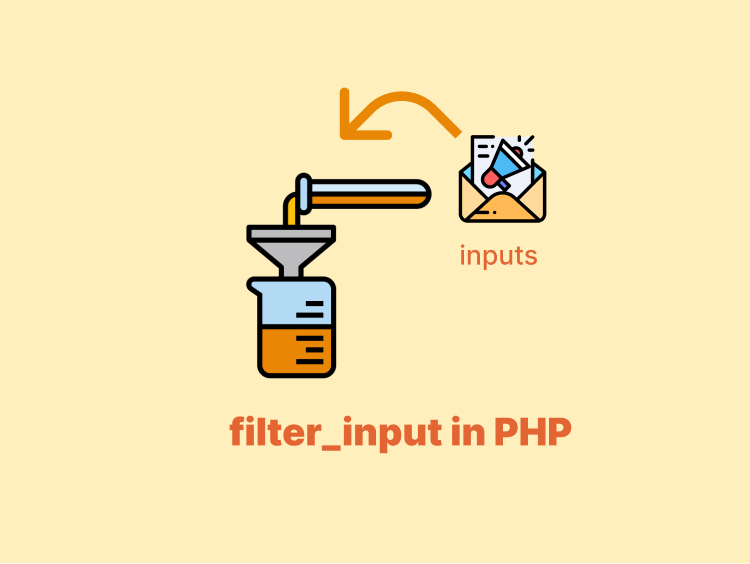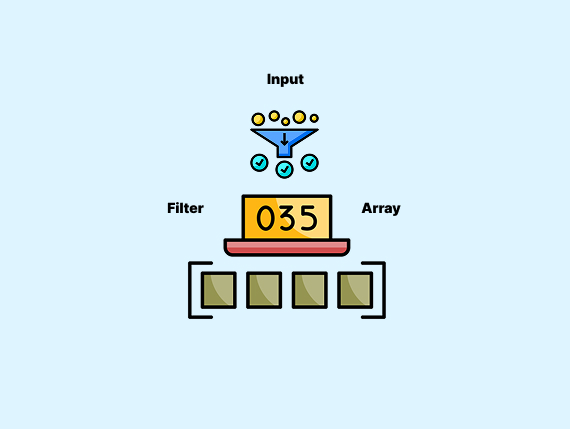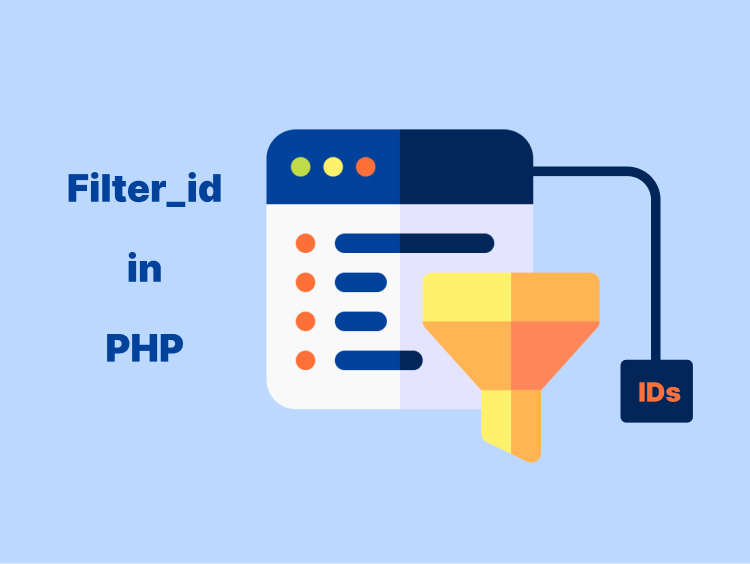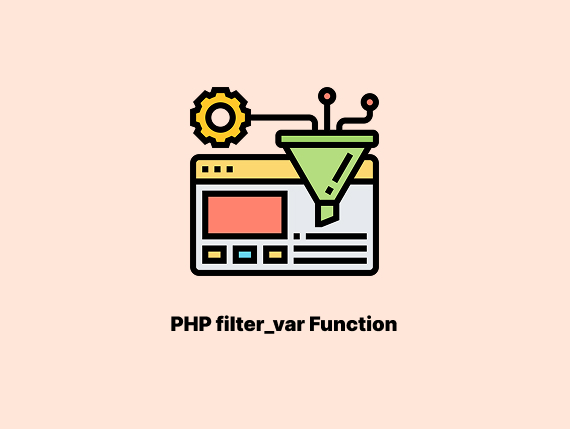User input can be risky. Hackers exploit weak validation to inject malicious data. PHP filter_input() helps you sanitize and validate input securely. Learn how to use it to protect your application.
What is filter_input in PHP?
The filter_input() is a built-in PHP function that retrieves an external variable, such as user input from GET, POST, COOKIE, SERVER, or ENV, and applies a specified filter to sanitize or validate the data.
It prevents security threats like SQL injection, XSS (Cross-Site Scripting), and invalid input. This makes sure that the expected data is processed.
Here is the syntax:
filter_input(type, variable_name, filter, options)Here are its parameters:
type(int, required) – Specifies the input source. Common values:INPUT_GET– Data from$_GETINPUT_POST– Data from$_POSTINPUT_COOKIE– Data from$_COOKIEINPUT_SERVER– Data from$_SERVERINPUT_ENV– Data from$_ENV
variable_name(string, required) – Name of the variable to filter.filter(int, optional) – The filter to apply. Default isFILTER_DEFAULT, which applies no filtering. Common filters:FILTER_SANITIZE_STRING– Removes special charactersFILTER_VALIDATE_EMAIL– Checks for a valid email formatFILTER_VALIDATE_INT– Ensures input is an integerFILTER_SANITIZE_URL– Cleans a URL
options(mixed, optional) – An array of additional options for filtering, such as setting a value range for integers.
So, why is filter_input used for sanitizing and validating input in PHP?
User input can contain malicious code or unexpected values. If you trust input without validation that exposes your application to risks. filter_input() helps in two key ways:
- Sanitization – Removes unwanted characters and makes sure input meets security and formatting rules.
- Validation – Checks if input meets a defined format
Hence, you use filter_input() to improve security. It also reduces manual error handling and makes code cleaner.
Here is a quick example:
$email = filter_input(INPUT_POST, 'email', FILTER_VALIDATE_EMAIL);
if ($email === false) {
echo "Invalid email format.";
} else {
echo "Valid email: $email";
}So, this code makes sure only properly formatted email addresses pass through. It returns false if input fails validation.
Types of Filters in filter_input
PHP provides two main types of filters for filter_input():
- Sanitization filters to remove or modify unwanted characters.
- Validation filters to check if input meets a specific format.
1. Sanitization Filters
To remove unwanted characters:
FILTER_SANITIZE_STRING(deprecated in PHP 8.1) removes HTML tags and special characters. Don’t use it in PHP 8+.FILTER_SANITIZE_SPECIAL_CHARSconverts special characters to HTML entities. It is needed to display safe output in HTML.FILTER_SANITIZE_EMAILremoves invalid characters from an email address.FILTER_SANITIZE_URLremoves invalid characters from a URL.FILTER_SANITIZE_NUMBER_INTkeeps only digits, plus (+), and minus (-) signs.FILTER_SANITIZE_NUMBER_FLOATkeeps digits and decimal points. Use withFILTER_FLAG_ALLOW_FRACTION.FILTER_SANITIZE_ENCODEDURL-encodes special characters. You can use it when you work with query strings.FILTER_SANITIZE_FULL_SPECIAL_CHARSconverts all special characters to HTML entities.
Here is an example:
$name = filter_input(INPUT_POST, 'name', FILTER_SANITIZE_SPECIAL_CHARS);
echo $name;Removes special characters from name input.
2. Validation Filters
This helps you to check if the input matches the expected format:
FILTER_VALIDATE_BOOLEANchecks if the input istrue,false,1,0,"yes", or"no".FILTER_VALIDATE_EMAILensures the input is a valid email address.FILTER_VALIDATE_URLensures the input is a valid URL.FILTER_VALIDATE_IPchecks if the input is a valid IP address (IPv4 or IPv6).FILTER_VALIDATE_IPwithFILTER_FLAG_IPV4. ensures the input is a valid IPv4 address.FILTER_VALIDATE_IPwithFILTER_FLAG_IPV6. ensures the input is a valid IPv6 address.FILTER_VALIDATE_INTvalidates that the input is an integer.FILTER_VALIDATE_FLOATHelps you to validate that the input is a floating-point number.FILTER_VALIDATE_REGEXPvalidates the input against a custom regular expression.FILTER_VALIDATE_DOMAIN(PHP 7.0+) checks if the input is a valid domain name.FILTER_VALIDATE_MAC(PHP 7.0+) validates that the input is a valid MAC address.
Here is an example:
$email = filter_input(INPUT_POST, 'email', FILTER_VALIDATE_EMAIL);
if ($email === false) {
echo "Invalid email.";
} else {
echo "Valid email: $email";
}This checks if the input is a valid email address.
Some filters allow extra options such as setting value ranges. Here is an example:
$age = filter_input(INPUT_POST, 'age', FILTER_VALIDATE_INT, [
'options' => ['min_range' => 18, 'max_range' => 65]
]);
if ($age === false) {
echo "Age must be between 18 and 65.";
} else {
echo "Valid age: $age";
}This makes sure age is an integer between 18 and 65.
Use filter_input to Validate Form Data
Using filter_input() to validate form data helps you make sure that the data entered by users meets expected formats and is safe for processing.
Below is an example of how to validate form data using filter_input(). Here is an example to validate form data with filter_input():
Consider a form where users enter their
- Email.
- Age.
- Website.
Here’s how you can validate each field using filter_input():
HTML:
<form method="POST" action="process_form.php">
<label for="email">Email:</label>
<input type="text" id="email" name="email" required><br><br>
<label for="age">Age:</label>
<input type="text" id="age" name="age" required><br><br>
<label for="website">Website:</label>
<input type="text" id="website" name="website"><br><br>
<button type="submit">Submit</button>
</form>Here is the PHP code:
$email = filter_input(INPUT_POST, 'email', FILTER_VALIDATE_EMAIL);
if ($email === false) {
echo "Invalid email format.<br>";
} else {
echo "Valid email: $email<br>";
}
$age = filter_input(INPUT_POST, 'age', FILTER_VALIDATE_INT, [
'options' => ['min_range' => 18, 'max_range' => 100]
]);
if ($age === false) {
echo "Age must be a valid integer between 18 and 100.<br>";
} else {
echo "Valid age: $age<br>";
}
$website = filter_input(INPUT_POST, 'website', FILTER_VALIDATE_URL);
if ($website === false) {
echo "Invalid website URL.<br>";
} else {
echo "Valid website: $website<br>";
}
Here is how it works:
- Email Validation:
- The
FILTER_VALIDATE_EMAILfilter ensures the email entered is in the correct format. - If the email is invalid, the function returns
false.
- The
- Age Validation:
- The
FILTER_VALIDATE_INTfilter checks if the input is an integer. - The
optionsparameter allows you to set a range for the integer. - If the age is not within the specified range, the function returns
false.
- The
- Website Validation:
- The
FILTER_VALIDATE_URLfilter checks if the input is a valid URL. - If the website is invalid or empty, it returns
false.
- The
Sanitize User Input with filter_input
Use filter_input() in PHP to sanitize user input from GET, POST, and COOKIE data. This function helps prevent security risks like SQL injection and XSS attacks.
Here is an example:
$email = filter_input(INPUT_POST, 'email', FILTER_SANITIZE_EMAIL);
$age = filter_input(INPUT_POST, 'age', FILTER_SANITIZE_NUMBER_INT);FILTER_SANITIZE_EMAIL: Removes invalid characters from an email.FILTER_SANITIZE_NUMBER_INT: Removes non-numeric characters.
Here is another example of sanitizing and cleaning data, but validation makes sure that it meets specific rules.
$email = filter_input(INPUT_POST, 'email', FILTER_VALIDATE_EMAIL);
$age = filter_input(INPUT_POST, 'age', FILTER_VALIDATE_INT);FILTER_VALIDATE_EMAILchecks if the email is valid.FILTER_VALIDATE_INTmakes sure the value is an integer.
So you have to sanitize first and then validate when needed. Use filter_input() instead of $_POST to improve security.
Wrapping Up
You learned how filter_input() helps sanitize and validate user input in PHP. You also explored different filters and their uses. Here is a quick recap:
- Sanitization filters remove unwanted characters to make sure clean input. Examples include
FILTER_SANITIZE_EMAIL,FILTER_SANITIZE_NUMBER_INT, andFILTER_SANITIZE_SPECIAL_CHARS. - Validation filters help you to check if the input matches a specific format. For examples include
FILTER_VALIDATE_EMAIL,FILTER_VALIDATE_INT, andFILTER_VALIDATE_URL.
Thank you for reading. Click here to see more PHP tutorials.
FAQ’s
What is filter_input() in PHP?
How do I sanitize user input using filter_input()?
$name = filter_input(INPUT_POST, 'name', FILTER_SANITIZE_SPECIAL_CHARS);
$email = filter_input(INPUT_POST, 'email', FILTER_SANITIZE_EMAIL);
$age = filter_input(INPUT_POST, 'age', FILTER_SANITIZE_NUMBER_INT);
How do I validate form data with filter_input()?
$email = filter_input(INPUT_POST, 'email', FILTER_VALIDATE_EMAIL);
$age = filter_input(INPUT_POST, 'age', FILTER_VALIDATE_INT, [
'options' =&amp;amp;amp;amp;gt; ['min_range' =&amp;amp;amp;amp;gt; 18, 'max_range' =&amp;amp;amp;amp;gt; 100]
]);What is the difference between sanitization and validation in filter_input()?
- Sanitization removes or modifies unwanted characters (e.g., stripping HTML tags).
- Validation checks if input meets a defined format (e.g., verifying an email format).
$email = filter_input(INPUT_POST, 'email', FILTER_SANITIZE_EMAIL); // Removes invalid characters
$valid_email = filter_input(INPUT_POST, 'email', FILTER_VALIDATE_EMAIL); // Checks if it's a valid email



